#kaytetye
Text
14 Indigenous Words for Money on New Australian 50c Coin
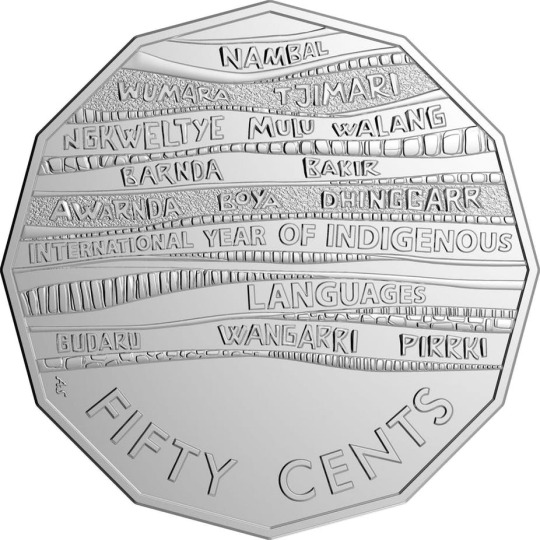
To celebrate International Year of Indigenous Languages, the Royal Australian Mint launched the new coins.
Money, or an object which abstractly represented the value of goods and services, did not exist in Australia before European colonisation. Trade occurred, but it was between items deemed to be of similar worth, for example, pearl shell, quartz, food or songs. With the entry of money into the Indigenous economy, new words were needed to refer to coins and later, notes.
Most Indigenous words for money come from words for “stone”, “rock” or “pebble”, no doubt in reference to the size and shape of coins. On the new 50 cent coin, you’ll find words for “stone” from across Australia:
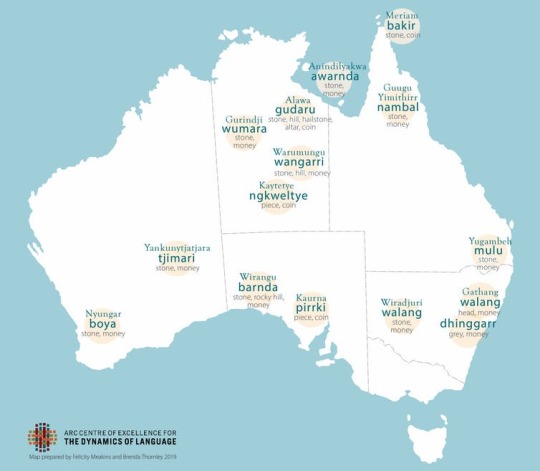
Source
#indigenous languages#aboriginal languages#gurindji#warumungu#alawa#anindilyakwa#nyungar#yankunytjatjara#meriam#yugambeh#guugu yimithirr#gathang#kaytetye#kaurna#wiradjuri#wirangu
367 notes
·
View notes
Text
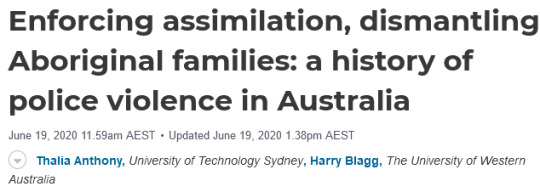

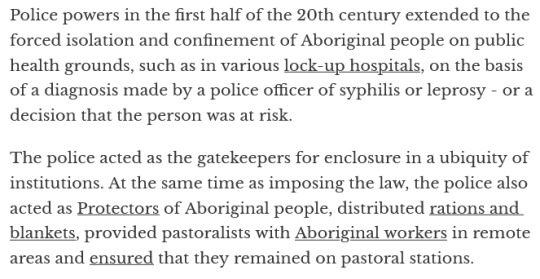
“Forced removal” references the unique role played by police in many settler colonies such as Australia, Aotearoa/New Zealand, the United States and Canada in relation to First Nations peoples: executing assimilationist policies designed to dismantle First Nations families. [...]

Mainstream histories of policing have looked to 19th century British Prime Minister Robert Peel’s London Metropolitan Police “British Model” of policing, with its focus on policing through consensus and “walking the beat”.
There is another model of policing, however, which better reflects the Australian history. Known as the “Irish Model” from its origins in suppressing dissent in the Irish colony in the 19th century, it set the police against the community, placed them in military style barracks, under a highly centralised and hierarchical chain of command. In general, they were not there to win hearts and minds.
Look to Chris Owen’s magnificent study of policing in the Kimberley region of Western Australia between 1882 and 1905 - titled Every Mother’s Son is Guilty. [...] As Owen shows, attitudes of the police towards First Nations people were deeply influenced by contemporary beliefs that they were inferior to whites, and a priori criminal. Many police officers in the frontier colonial era were conscious of being part of a “civilizing mission” and held highly paternalistic attitudes. One officer who policed the remote regions of Western Australian in the 1920s recalls being “conscientious in my desire for their welfare, for I looked upon them then, as I do now, as children.”

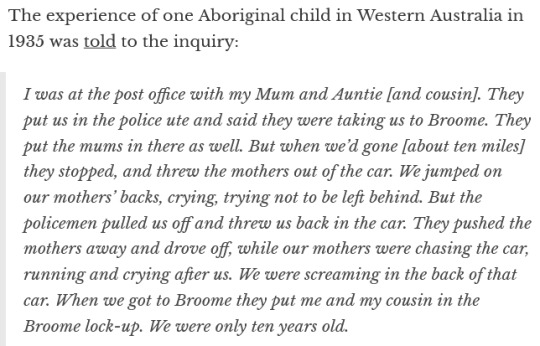
Elsewhere, officers exercised often unfettered brutality in punitive frontier expeditions. This was in pursuit of pastoral land grabs, settler occupation and the disintegration of Aboriginal families.
This was a feature of the Native Police Forces that operated in various parts of Australia from the 1830s until the early 20th century. These forces, responsible for many atrocities against Aboriginal people, consisted of Aboriginal troopers under the command of white officers such as Constable William Willshire whose killings resulted in an unsuccessful murder trial in 1891 [...]. Historical accounts of the Northern Territory’s Native Police, modelled on the Queensland’s Force, documents its fatal force against Aboriginal lives to allegedly defend colonists’ lives and property.
In Western Australia, the 1927 Royal Commission into the killing and burning of Aboriginal bodies in the Forrest River massacre found police were brutal in effecting arrests.
The use of police brutality extended beyond Native Police expeditions, and was characteristic of police powers more widely. The Colonial Frontier Massacres Map documenting massacres of First Nations families across Australia include extensive records of police killings, such as 60 Warlpiri, Anmatyere and Kaytetye women, men and children in the Coniston Massacre in 1928.
Police practices of neck chaining Aboriginal prisoners continued officially into the mid-20th century in parts of Australia.
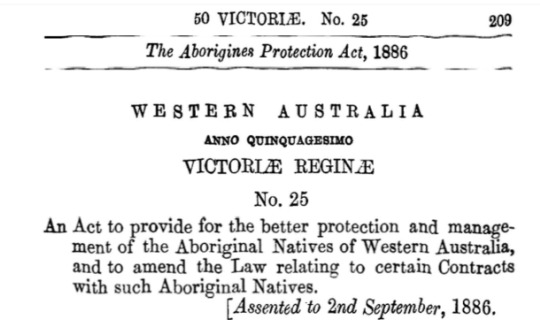

Ideas of law and order formed only a fragment of the colonial police role where Aboriginal people were concerned. Much of it was taken up with implementing the “Aboriginal Protection Acts” or simply “Aboriginal Acts”, which continued well into the 20th century. [...]
Aboriginal Acts were used in practice to forcibly relocate Aboriginal people to a place of prescribed confinement, which in practice could include on government settlements, reserves, church missions, hospital lock ups, penal islands, cattle stations and other institutions. [...] Police also gained specific powers under legislation that allowed them to remove Aboriginal children from their families under “child welfare” legislation. [...]
Police powers in the first half of the 20th century extended to the forced isolation and confinement of Aboriginal people on public health grounds, such as in various lock-up hospitals, on the basis of a diagnosis made by a police officer of syphilis or leprosy - or a decision that the person was at risk.
The police acted as the gatekeepers for enclosure in a ubiquity of institutions. At the same time as imposing the law, the police also acted as Protectors of Aboriginal people, distributed rations and blankets, provided pastoralists with Aboriginal workers in remote areas and ensured that they remained on pastoral stations.
Aboriginal people who defied Aboriginal Protection Acts and the rules of reserves and settlements - such as speaking in language, practising culture, marrying without the protector’s permission, or otherwise disobeying orders of the protector - would be sent for punishment to places such as Palm Island.
---
All text above published by: Thalia Anthony and Harry Blagg. “Enforcing assimilation, dismantling Aboriginal families: a history of police violence in Australia.” The Conversation. 19 June 2020. Images show screenshots of headline, subheadings, and illustrations as they also appear originally published in the article. [Bold emphasis and some paragraph breaks/contractions added by me.]
473 notes
·
View notes
Text
The Coniston Massacre
The Coniston Massacre is the name given to the officially-sanctioned murder of hundreds of Indigenous people of the Warlpiri, Anmatyerre, and Kaytetye tribes, committed by Northern Territory police and landowners in 1928.
The massacre was motivated, ostensibly, by the murder of Fred Brooks, a white station hand who worked at Coniston Station. In retaliation, William George Murray led a series of expeditions in search of Brooks’ murderers. Murray and his party indiscriminately murdered almost every Indigenous man, woman and child they came across. The number of murders in the official record is 31, but the true number of Indigenous people killed in this series of attacks is believed to be around 200.
EPISODE NOTES:
The Coniston Massacre is one of many atrocities committed against Indigenous peoples by white settlers – atrocities that began on January 26, 1776, and continue in various forms to the present day.
Whatever your feelings about Australia Day, it cannot be denied that Australia has a continuing history of violence towards the Indigenous people of Australia. Indigenous people have lived on this land for over 100,000 years, and in the less than 300 years of white settlement, we have destroyed the land, marginalized its first peoples, and placed hundreds of refugees in offshore detention centres. We need to fix these systemic issues, and find a day when all people can celebrate all of the many incredible things that this great Southern land has to offer.
To watch the Coniston Film, go here https://rebelfilms.com.au/films/coniston/
To read more about the massacre from the Central Land Council, go here https://www.clc.org.au/files/pdf/Making_Peace_with_the_Past.pdf
To read about the Northern Territory police apology for the massacre, go here https://www.abc.net.au/news/2018-08-24/nt-police-apologise-for-state-sanctioned-coniston-massacre/10162850
If you like what we do please consider supporting us on PATREON
Subscribe to the podcast on ITUNES, STITCHER, SPOTIFY or your podcatcher of choice.
Find us on FACEBOOK, TWITTER, INSTAGRAM or EMAIL us on [email protected]
www.thatsnotcanonproductions.com
#true crime#crime#investigation#police#australia#justice#podcast#brisbane#forensic#evidence#murder#criminal#tasmania#victoria#new south wales
0 notes
Photo
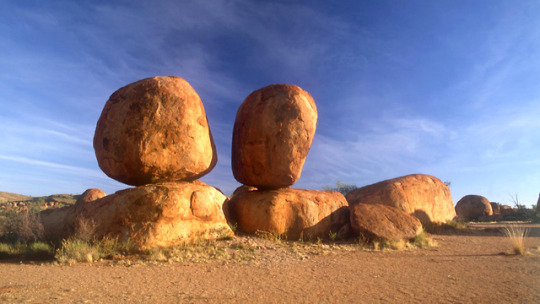
Devil’s Marbles
Devils Marbles is one of the world of the wonders
Devils Marbles are huge granite boulders scattered across a wide range, cover valley, 100 kilometres south of Tennant Creek in the Northern Territory.
This place is amazing and wonderfull mant tourist come to here for taking picturesThe Devils Marbles are located in the traditional country of the Warumungu, Kaytetye, Alyawarra and Warlpiri people. They call the Devils Marbles Karlu Karlu, which actual meaning or translates as ‘round boulders'.
0 notes
Text
Darwin to Alice Springs – A Road Trip Through the Australian Outback
Travelling from Darwin to Alice Springs and crossing through the Outback of Australia has always been in the top crop of my must-do travel experiences. Over the past two years travelling in the country, I recently found myself having touched upon all States of Australia in some way or another, with only one left to conquer – The Northern Territory.
After some time spent traversing the cities and aboriginal lands of Western Australia, I took a flight from Perth to Darwin to start another adventure into more of the country’s dry, dusty hinterland – that of the mysterious and hard to traverse Outback.
Darwin didn’t excite me, despite its crazy-fun wave pool, outdoor cinema, evening markets and scenic-historical walking spots. Sadly, its rough and rowdy backpacker scene largely offsets the rural calm. However, it is the place you come to see Litchfield or Kakadu National Parks and all the crocodiles for which this area is famed.
Or, like me, you come here to begin a five-day overland journey through the Outback that finishes up in Alice Springs for the Uluru (Ayers Rock) highlight.
Before arriving in Darwin I had no idea how to go about this trip. People mostly try to do it themselves and road trip for days, despite warnings not to travel through the Outback alone and without proper navigation skills, contacts and equipment. I felt that by flying from Darwin to Alice Springs I would miss out on the beauty of what is essentially the beauty of the ‘nothingness’ in between and nature at its most untouched. But I found an answer, setting out on a five-day trip with a company called Mulgas, who came highly recommended from hostels and travel agencies in the city.
Outback Road Trip Day 1: Leaving Darwin for Edith Falls, Mataranka Thermal Springs & Daly Waters
It’s an early start around 6am, but it adds to the sense of adventure as you hit the road, ready to join the open highway that starts to cut through the outback. To break up the long journey, which could otherwise turn monotonous, we stopped at Edith Falls in the Nitmiluk National Park, to take a relaxing swim and stretch our legs. Here we found a sign saying that visitors should avoid the waters between 7am and 7pm because of the crocs, so a far out swim to the waterfalls was slightly marred by our in-depth talk of whether crocodiles can tell the time and stick to their curfew.
Passing through the nondescript town of Katherine is simply for the purpose of a snack stop, on the way to the serene Mataranka Thermal Springs for another swim. Here you can wade through small pockets of jade and emerald waters set within a dense palm forest.
The highlight of the long day’s drive though is the first over-night resting stop – Daly Waters. Just over 600kms south of Darwin, this quirky, tiny town is a fascinating pit stop with a historic pub that has been open to the public since 1938, when people from the nearby airfield used to pass through, leaving an eclectic mix of memorabilia.
Outback Road Trip Day 2: Devil’s Marbles & Alice Springs
The second day meant pressing forward farther south in order to arrive in Alice Springs by evening, but not without a visit to the natural wonder that is Karlu Karlu (The Devil’s Marbles). A scattering of rounded granite rocks that appear to have popped out of the desert floor marks this holy Aboriginal site. In fact, these rounded towers have been formed by erosion over millions of years, creating a magical balancing act.
As a protected site under Northern Territory Aboriginal Sacred Sites Act, visitors will never have full access to all its secrets. However, as a visitor, you will hear of some ‘Dreamtime’ stories of the Whyungu, Kaytetye, Alyawarra and Warlpiri people, including the one about an ancestor who dropped individual strands of hair that turned into the rocks, and who still resides there today.
A drive along the Stuart Highway towards the ‘Red Centre’ would not be complete without a quick stop at Wycliffe Well – the ‘UFO Capital of Australia’ said to have had the most sightings and visits in all of the country. The cafe, including it’s crazy exterior, is decked out in everything alien themed, and features news clippings from the abduction and sighting stories over the years.
Outback Road Trip Day 3: Uluru, the Icon
After an overnight stay in an Alice Springs hostel, a 6am start marks the point of one of the most exciting parts of the trip – the journey to Australia’s most famous red icon, Uluru.
Everyone’s heads turn in the bus as we approach this infamous masterpiece of Mother Nature. It’s bold, fiery and dominant. Today is the chance to hike around a huge part of it after a guided introduction tour, see it up close, and understand how sacred it is to the Aboriginal people.
So much so that many parts of it are completely off-limits for photography. It radiates a scared feeling that you can’t quite put into words until you stand before it and its rugged ochre walls. It’s heartbreaking to see people climbing it when signs clearly dictate how much this offends the Aboriginal people. Mulgas does not advocate climbing Uluru, yet is not at liberty to stop people either, and it was hard to stand by and watch a few members of my group do so, which is both dangerous and utterly selfish. Respect the ancient culture and don’t do it.
A day exploring Uluru is not complete without a glass of bubbly and watching the sunset over this iconic rock formation, toasting to new friends and being at one with the very best of nature’s creations. While out here, we got to set up camp nearby, hunt for firewood and sleep outside under the stars in swags – a true Australian Outback experience.
Outback Road Trip Day 4: Uluru Sunrise & Kata Tjuta Hike
Starting the day watching the sunrise over Uluru for good spiritual measure, this was the day we got to explore the wider area by driving to Kata Tjuta and setting off for a long walk through the Valley of the Winds.
The Kata Tjuta are a bundle of 36 red rock formations that span over 20km. Another holy site set within a now protected National Park, the stones are said to date back more than 500 millions years. It’s an arduous hike in the heat so it’s best to start as early as possible and aim to be finished before the midday high sun.
Outback Road Trip Day 5: Kings Canyon Hike
The Kings Canyon rim walk hike is a highlight of this trip. Think of it as an Australian Grand Canyon – wide, deep caverns, steep ledges and deep-drop viewpoints. We meandered its North and South walls, The Garden of Eden, as well as the Natural Amphitheatre taking in the adrenalin of standing close to mighty ledges and tackling the rocky steps for the ultimate panoramic vistas.
Tired and able to sleep in the van, we rolled back on the highway to Alice Springs. We had travelled the Outback like true adventurers while knowing we were only visitors in a very sacred space that we will never truly know or comprehend.
Things to Know:
The five-day Mulgas tour (which departs in both directions of Darwin to Alice Springs and Alice Spring to Darwin) costs $629 Australian dollars. The standard Alice Springs to Darwin ‘Express’ tour (which doesn’t include the three-day Uluru tour and hikes) is $289. A more fun, scenic and cheaper alternative than flying.
Care is taken to respect the Aboriginal rights at every site visited. Tourism access to certain places still remains a contentious issue, and it is of upmost importance to abide by the rules and adhere to the ancient culture of the rightful owners of the land.
Further information on travelling in the Northern Territory can be found here.
The post Darwin to Alice Springs – A Road Trip Through the Australian Outback appeared first on Borders Of Adventure.
via Travel Blogs http://ift.tt/2r3tr5W
0 notes
Link
by Myfany Turpin and Katherine Demuth
Kaytetye is an Aboriginal language of central Australia. It has an estimated 250 speakers, including the younger people whose variety differs significantly (Turpin and Ross 2012). Kaytetye belongs to the Arandic subgroup, which is part of the larger Pama-Nyungan family that once covered some 90% of Australia. It is bordered by two Arandic languages to the south and the east; and two languages from other subgroups in the north and west. Kaytetye is not mutually intelligible with its neighbouring languages and whilst traditionally multilingualism was the norm, language shift is now taking place to an English based creole.
http://www.assta.org/workshops/Rhythm2012/TurpinDemuth.pdf
1 note
·
View note